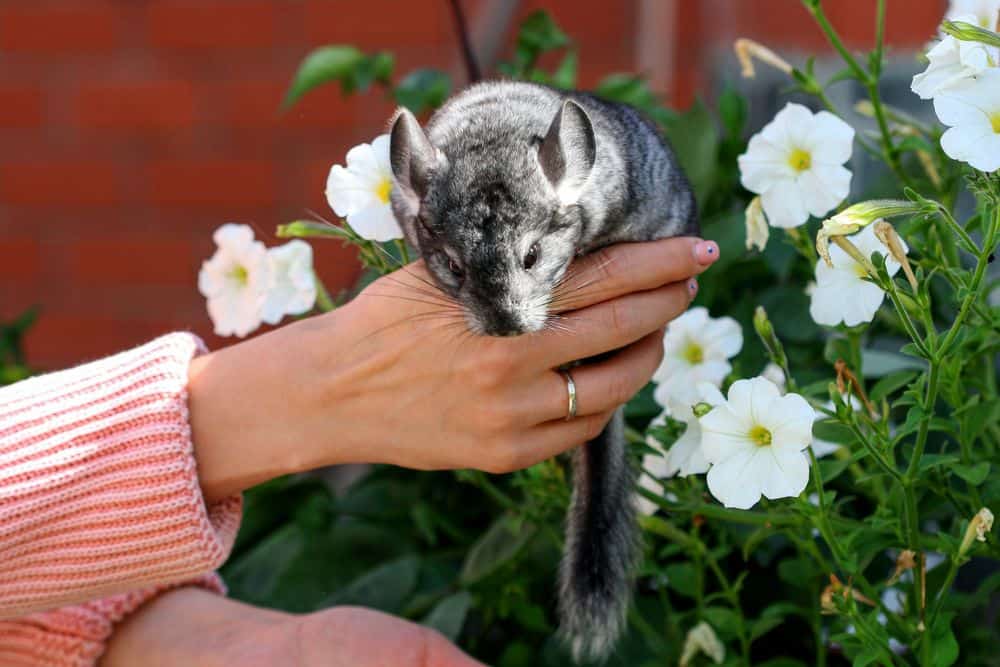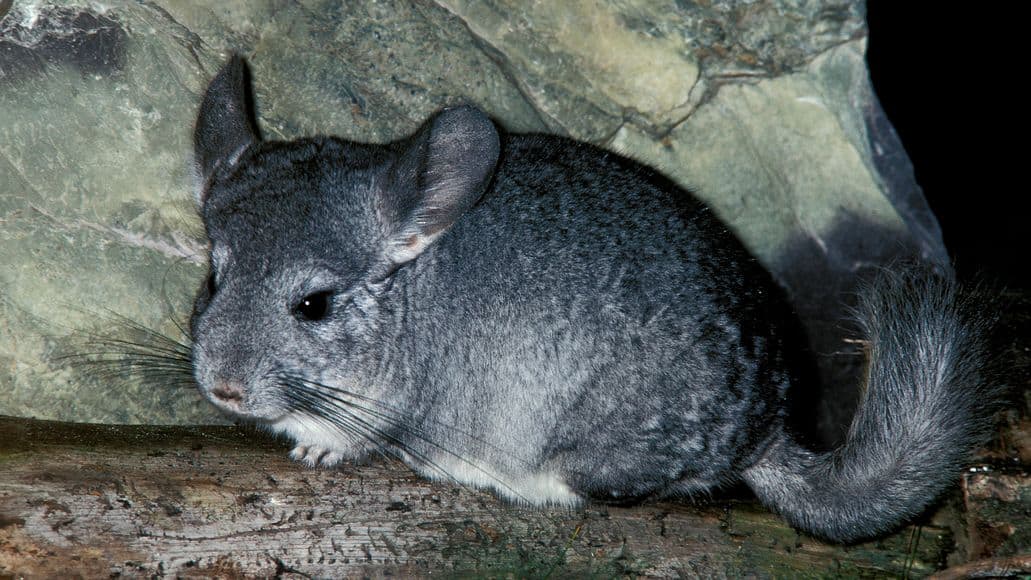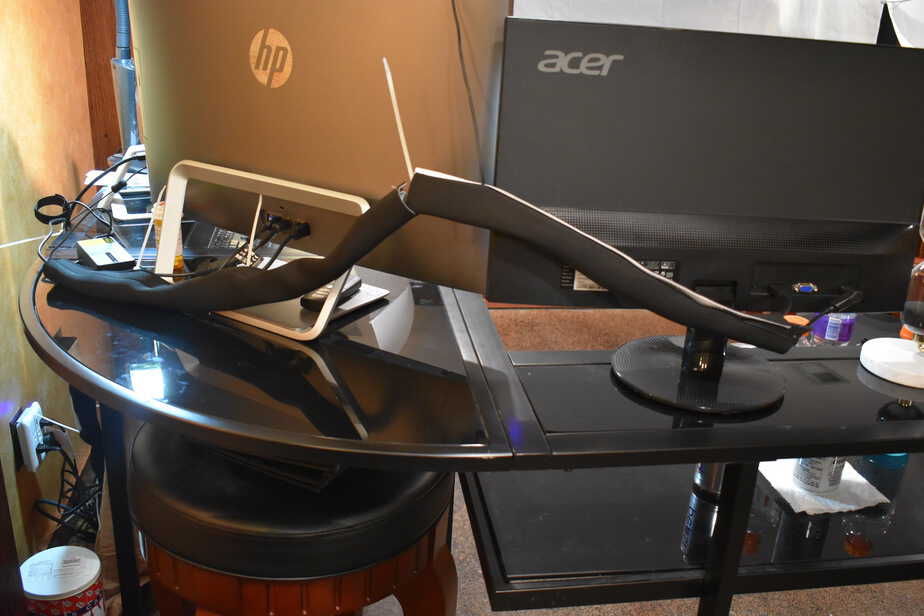
Do you already have a spot picked out in your back yard for your new pet?
Well, I have some bad news for you.
Your chinchilla can not live outside.
You may have seen some caveats on other websites that state you can keep your chinchilla outdoors if you meet certain conditions.
But that is far too risky, for a number of reasons.
Keep reading to learn if a chinchilla can live outdoors and why keeping yours outside is so dangerous. You absolutely need to know this information.
Contents
Can Chinchillas Live Outside?
No, chinchillas can’t live outside. These sensitive rodents must remain at regulated temperatures between 50° F and 70° F.
Temperatures above this range will cause overheating and death. Temps below 50° F will cause illness and death. For this reason alone, chinchillas need to remain indoors only. Chinchillas absolutely can’t live outside.

Why Chinchillas Can’t Live Outside
First and foremost, I don’t want to confuse you. Obviously, chinchillas live outside in nature. But they live in a very specific habitat.
Chinchillas are wild animals. There are actually two types. They are referred to as the chinchilla and the chinchilla laniegera.
Both types are native to the Andes mountains in South America. Chinchillas originate from Bolivia, Peru, Argentina, and Chile. But the vast majority of wild chinchillas are found in Chile.
Chinchillas are endangered, in large part due to humans hunting them for their fur. Luckily, they have made a bit of a comeback, despite the harsh conditions where they live and all the danger from humans and other predators (but they are still endangered).
It only makes sense to assume that chinchillas can certainly live outside.
Well, I hate to break it to you, but this is 100% incorrect.
The reason chinchillas can thrive in the wild in their geographical location is that those areas, while harsh, have mild temperatures, low humidity, and minimal amounts of rain.
Chinchillas are theoretically easy to care for, but only if you handle certain specific things. For starters, they can’t live in temperatures above those we mentioned above.
Keeping a chinchilla at ideal temperatures is vital. Not doing so can easily result in death. Heatstroke is not uncommon with chinchillas. This is due to their inability to sweat and release heat and the fact that the chinchilla has the densest fur out of any land animal.
If you feel your chinchilla might potentially be overheating, you can always use my “checking the inside and outside of the ears technique” to determine if it is, in fact, overheating.
It’s easy to do. Basically , if the blood vessels become more visible or the ear is red, that is an indicator that your chin is too hot.
Chinchillas also can’t drop below certain temperatures to avoid developing respiratory infections and other illnesses that may potentially lead to health problems and even death.
Clearly, in most areas of the world, it’s going to be tricky to remain between 50° and 70° and low humidity at all times. The only way to do so is to ensure your chinchilla is housed in a climate-controlled environment indoors.
But climate isn’t the only concern you could potentially run into, if you attempted to keep your chinchilla outside. Let’s touch on some of those other potential issues next.
Other Safety Issues With Chinchillas Living Outside

Another problem you need to keep in mind is that chinchillas can’t get wet. While I’m assuming you had no intention to allow your chinchilla to roam free and risk the potential of your chinchilla running away from you, other hazards may present themselves that could cause your chinchilla to get wet.
You may not have considered that if you were planning on using some type of outdoor cage, the cage would still need to breathable. That adds the risk of crosswinds and moisture getting to your chinchilla.
A chinchilla’s fur is too dense and can’t dry if it gets wet. This has the potential to cause your chinchilla to develop fungal infections or other illnesses that can potentially lead to death.
Don’t forget about other animals either.
If you let your chinchilla live outside, it’s likely that other animals will sniff it out quickly. Chinchillas do have the ability to slip their fur as a defense mechanism, but outside of that, they don’t really stand a chance against predators.
Lighting Conditions Can Also Impact Your Chinchilla
Light is a consideration that’s not discussed often, but it is something you need to factor in. Chinchillas are crepuscular rodents and being indoors is something that they can get used to.
In fact, chinchillas, in general, adapt to their environment quickly. However, light shining down on your chinchilla for most of the day may not be the best approach.
It’s not that that chinchillas love the dark, necessarily. While chinchillas can see in the dark, they see about as well as we do. And like us, they don’t necessarily mind light, but they do prefer to sleep in dark places.
For example, my chinchilla sleeps most of her day inside of her hut hideout. It makes her feel safe and gives her a sense of security. This is another big reason that a chinchilla shouldn’t live outside.
Being Indoors Doesn’t End Your Safety Concerns

Keeping your chinchilla indoors is vital. But doing so does not mean there are no more dangers. There are plenty of hazards indoors as well.
And some of them are the same. The difference is that you have control indoors. For example, you need to make sure that your indoor areas are held at the proper temps.
Additionally, you want to have all the wires covered that your chinchilla could chew during playtime. Outside of factors like these, the indoors is safe. It is certainly 100% safer than allowing your chinchilla to live outside.
Can My Chinchilla Live In My Garage Or Shed?
I see this question come up frequently. I understand the inquiry and why you may want to know if this would work.
In theory, the answer is yes. But it depends on the garage or shed in question.
If the garage or shed is climate controlled, then it may be just fine. Personally, I would never consider it. But in theory, I can’t say that it wouldn’t work, because it may.
If your garage or shed is not climate controlled, it’s absolutely off-limits. Your chinchilla can’t live in an uncontrolled environment like that. At some point, it will end up overheating or freezing.
Will A Heat Lamp Improve My Chinchilla’s Chances Of Surviving Outside?
I personally don’t like this either, but I suppose with meticulous planning, it may work. But I would never personally trust it.
However, I do know that some people have had success using these methods. Heat lamps have been used for years for specific pets that need specific temperatures to survive, such as rabbits. That would be one way to keep a chinchilla warm in the cold winter months.
However, I would personally be worried that the heat might produce to much heat for your chinchilla. Without very close supervision, I don’t think this is a viable path to take.
However, the choice is ultimately yours. If you have a good solid game plan in place, then more power to you. Be sure to share your comments and stories below for the rest of us. It will be valuable for other chinchilla owners.
Chinchilla Living Outside: Final Thoughts
Chinchillas can’t live outside, and you run the risk of death doing so. They really shouldn’t be outside at all, even for short periods, like for a walk while wearing a harness or collar with a leash.
However, in certain situations, you may be able to pull it off using a garage or shed or heat lamp. But again, if it were me, I would only adopt a chinchilla with the intention of keeping it indoors and not exposed to the outdoor elements.
Of course, that’s only one man’s opinion on the matter, and now I’m going to turn the floor over to you.
Please let us know what you think about this topic.
What are your thoughts about a chinchilla living outside?
Do you believe there are situations where you could have your chinchilla live outside?
Be sure to share your thoughts, stories, and concerns by dropping a comment below.
As always, Chili and I appreciate you reading and we will catch you next time!
Leave a Reply